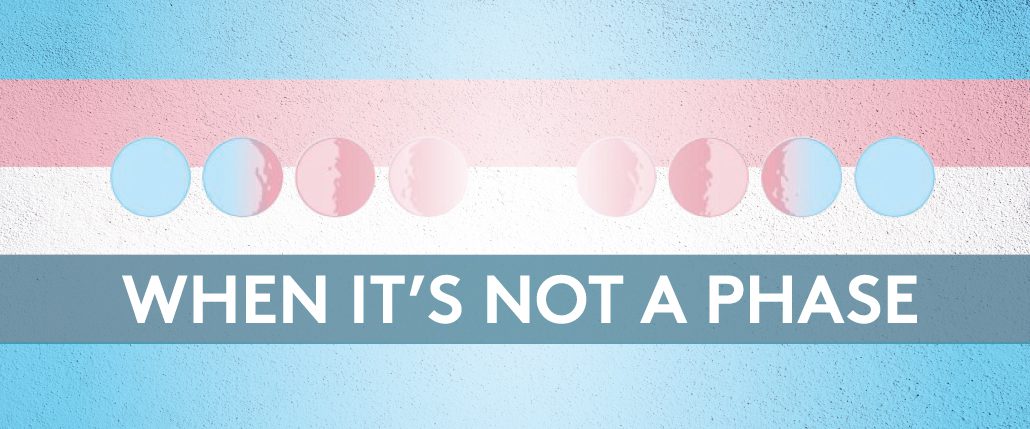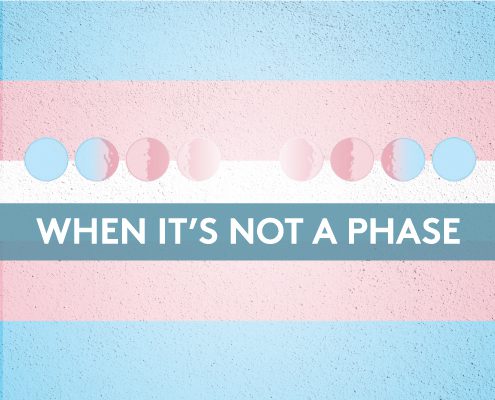When It’s Not A Phase

When It’s Not A Phase
Parents of transgender children are often asked, “When did you suspect?” The answer to that question varies as no two kids are alike. But a common theme often emerges: there wasn’t one single instance, but rather dozens of small signs that added up to “suspecting.”
Some examples of “signs” that parents have noticed is the insistence on stereotypical “girl” or “boy” clothing, hair styles, and toys that do not correlate to the child’s biological gender at birth. Many parents share that when their child is told they cannot wear the clothes they prefer, or not allowed to play with certain toys, their child expresses intense sadness. But when allowed to express themselves in the clothing and hairstyles of their choosing, their child is filled with joy. The collection of these signs point to an unwavering truth: their child knows their gender identity.
It is important to acknowledge when a child is asserting things about themselves that are a part of their identity. For some parents this can be overwhelming and confusing.
Researchers at the University of Washington found that gender identity (the concept of knowing whether one’s self is male, female, or non-binary) is as strong in transgender kids, including those who are neurodiverse, as it is among typically developing children. An interesting component of this study is that transgender children’s gender development mirrors that of neurotypical and neurodiverse children, and that they can start to identify with clothes and toys in line with their authentic gender from a rather young age.
Gender – defined
An infant does not know what it means to be a boy or girl. They discover the meaning of these words from their parents, older children, and the people in their lives. Young children also receive a lot of messages from their culture and the media: boys wear blue clothes and like sports, and girls wear pink and like to play with dolls. But a person’s actual gender does not exist in the binary terms of boy/girl and male/female. Rather, gender is more of a spectrum with people expressing and identifying with degrees of masculinity and femininity. Feeling comfortable with our own gender identity and expression is vital to the way we see ourselves and how we engage with the world.
A transgender person identifies along this spectrum, but also identifies as a gender different from the one biologically assigned based on genitalia. A child is deemed to be transgender by behavior and expression that is consistent, insistent, and persistent about their identity. A transgender child will typically insist over the course of many years that they are not the gender they were assigned at birth.
For transgender kids, family and commuinity support is essential to establish comfort in their true sense of self. Research has shown that when a young person receives affirmative support from parents, grandparents, family members, teachers, and peers, there is greatly improved mental health and well-being. It is important to point out that the research shows that transgender young people are at a greater risk of suicide as a result of rejection and bullying. The reality is, support for a transgender child can make all of the difference to insuring that your child is thriving.
Parenting a Transgender Child
Parents of transgender children go through a transition process along with their child, and that transition carries with it a lot of emotions. A parent may feel genuinely happy and excited for their child as they embark on this new journey, but there may also be feelings of confusion, sadness, anger, and loss. When a child tells their parents that they are not the gender they were biologically born with, a parent can feel frightened and unsure about what the future may hold for their child. Parents of transgender children should remind themselves that all feelings about this experience are valid.
Experts suggest that parents be kind to themselves but also work through their emotions away from their child and perhaps with the care of a mental health professional. Each family member may react differently and come to acceptance at different times. Talking about this experience with a therapist can be helpful. The Kaleidoscope Program provides therapeutic services for neurotypical and neurodiverse transgender children, and their parents. Our therapists have expertise with supporting neurotypical and neurodiverse transgender children and their families, and can provide guidance and tools to assist with the transition.
It may not be a phase.
While many children and teens go through “phases” such as dying their hair black, or being obsessed with a celebrity, this is very different than being transgender. It can be very hurtful for a transgender child if a parent dismisses their thoughts and behavior as a phase. Many transgender children rely on their parents and family members for support and acceptance, as they may not experience acceptance in environments outside of the home.
Parents can show support for their transgender child in a number of ways. To begin, parents should try to make a true effort to use the names and pronouns that align with their child’s gender identity. Further, parents can advocate for their child at their school to make sure there are systems in place that will support and protect their child such as gender neutral bathrooms and locker room spaces. And most importantly, assure your child that they have your unconditional love and support – always.
Thank you Bryan for your insight and guidance. If you are interested in joining our Kaleidoscope Parent Group or have questions about the group, please email.


